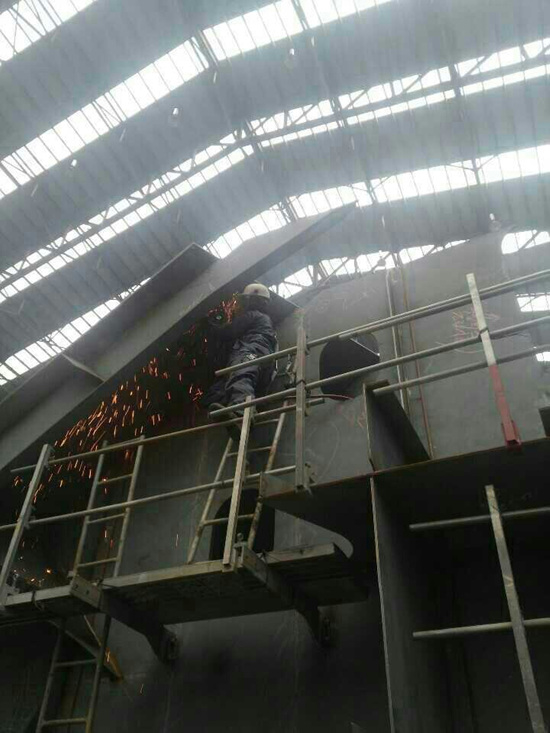Head opened, leg broken..No Worker’s Compensation!
Flashing back 10 years ago in shipyards, there were so many deaths. While welding in a dark LPG cargo tank, he saw a ‘devil-like blooming’ smoke from the tank. It was a fire. The friendly shout of “Bro, come out and have some bread” changed to a scream of “Get out!”. His colleague who told him “Let’s have something and take a break” just a while ago did not come out of the ship alive on that day. He let so many friends go in that way for the last 10 years.
He also just missed several fateful moments. He had his head opened, ribs broken and back hurt many times. However, he never claimed the Worker’s Compensation for fear of reprisal from his employer in Ulsan shipyard.
The shipyard welder, Mr. Young-bae Kim (52) who worked for 11 years at shipyard said, “Hyundai Heavy Industry (refer to as HHI below) was built by our worker’s deaths”.
Subcontracting company owner begged “Help me” when requested Worker’s Compensation
“When I was admitted at the hospital due to broken ribs, it wasn’t even informed to the safety department in HHI. If someone is injured, it should be reported but injuries are usually concealed.”
In August last year, Mr. Kim a subcontract worker of Hyundai Mipo Dockyard fell down from a 2 meter high scaffold. He was chased by the manager that the process was behind schedule and he had to rush to finish even working after hours.
As he welded, sparks flew up everywhere and the flames also went into Mr. Kim’s work shoes. Worried about a burn, he was just about to take off his shoes and the stepping scaffold collapsed. He fell down to the piled equipment and was injured.
There are scaffolds set around the worksite in shipyards, so that they can easily access to work in height but it was loose at the time of injury. ‘The accident was waiting to happen’.
As the fall wasn’t considerably high, he thought it was a minor contusion but he couldn’t move himself or talk. It was a rib fracture.
He was admitted at the hospital. The day after the incident, the subcontracting company manager called him. His first word wasn’t ‘how are you? Are you okay?’ but blame “I’ve seen so many workers with fractures at the shipyard but you’re the one who was admitted at the hospital”.
“I didn’t mean to request the Worker’s Compensation. While working for a shipyard, I have been injured several times, I’ve never thought of the Worker’s Compensation. Not just because of the work atmosphere for subcontract workers but also I can’t cause damage to my company…”
Even though you are injured at work, conceal first. This is an unwritten law for subcontracting companies at shipyard so many occupational injuries are covered up. Though people cut their hands by grinder, break bones by fall from a height, they either pay out of their pocket saying ‘injured at home’ or their subcontracting companies pay medical expenses (providing treatment cost or other compensations under the condition that workers do not request the Worker’s Compensation). This is due to the ‘invisible rule’ that subcontract worker who applies for the Worker’s Compensation must leave the company.
“The shipyard owner gives subcontracting companies pressure to achieve ‘incident free’ environment and subcontracting companies conceal occupational injuries to gain more contracts or renew contract with shipyard but they can no longer hide if their worker reports to Worker’s Compensation. Then, the reported worker cannot survive in the subcontracting company anymore.”, the Metal union HHI branch director, Mr. Chang-min Ha said. He has recently conducted ‘Investigation for Occupational injuries concealment’ six times.
Following the accident, Kim wanted to process his case through the Worker’s Compensation but he agreed to be treated according to their regulation due to company’s ‘pressure’ or ‘begging’. When he first mentioned the Worker’s Compensation, his company owner who never even called him for over a week after the injury came and begged ‘Help me’. His company wasn’t even insured for Worker’s Compensation.
pic : subcontract worker
More than half of HHI subcontract workers, ‘self-pay for work related injuries’
Kim was a rather lucky case. Through long negotiation with his company, he received all treatment cost and 100% daily rate for the days he missed during his admission. It was due to the obvious fault of the company not joining the Worker’s Compensation.
However, most can’t even claim the Worker’s Compensation. According to Hanlim University Education-Industrial Cooperation’s ‘Research for occupational injuries risk high jobs’ requested by National Human Rights Commission last year, only 7.2% of subcontract workers who experienced an occupational injuries benefited from the Worker’s Compensation. 60% were paid by their subcontracting companies, 28% paid out of their own pockets for treatment and 4.8% didn’t even seek treatment.
As to why they did not apply for the Worker’s Compensation (including plural response), the answers were ‘To avoid any disadvantages from shipyard or subcontracting company’ came the first (79) then, ‘By the subcontracting company’s request to not to apply for the Worker’s Compensation’ followed (52).
It was even more serious in HHI alone. According to ‘Investigation for Subcontract workers’ working environment’ conducted by HHI union and subcontracting branch, self-paid for work-related injury was 50.4%, which was more than half. Paid by their subcontracting companies was 43.7% and the Worker’s Compensation case was only 3.7%.
For the reason why cases were not dealt through the Worker’s Compensation process, more than half, 50.9% responded ‘being afraid of disadvantages such as dismissal, subcontracting company’s shut down and being nominated in a blacklist’. ‘By the Subcontracting company’s request followed by the shipyard owner company’s pressure’ came the next at 22.3% and ‘not knowing any information about the Worker’s Compensation application’ followed at 17%.
In conclusion, the vicious circle runs around by subcontracting companies pushing their workers to avoid disadvantages from the shipyard and subcontract workers obey what their companies ask due to the job security.
“In subcontract worker’s point of view, the longer their companies delay time asking to do their own compensation process the more they become anxious. It is a kind of anxiety, ‘Can I return to work after recovery?’.”
Subcontracting companies also put a tearful face on. Even though they want to handle the work injury case through the Worker’s Compensation as per worker’s request, they are not able to ignore the pressure from shipyard. One anonymous HHI subcontracting company manager interviewed with
and he said, “We have paid all the Worker’s Compensation fees and I am more than happy for work injury cases to go through the Worker’s Compensation, not paying out of my pocket. If that’s the case however, you will get visible and invisible stress from the shipyard management and be disadvantaged in the contract renewal. Do you think subcontracting company owners want to conceal their worker injuries?”The astronomical amount of the Worker’s Compensation fee, ‘shipyard of death’ was exempted
In this way, the Worker’s Compensation fee HHI exempted in 2013 was 17 billion won (approx. $15 million)
Sum up the exemption amount for last 5 years (2009~2013), it reaches up to 100 billion won (approx. $90 million). This is because of the structure that counts only their directly hired employees regardless the number of injured subcontract workers and that’s why the ‘outsourcing of danger’ is putting more subcontract workers into dangerous works and is becoming accelerated.
Thus, it is pointed that the statistics of critical occupational injuries should be based on the shipyard not the individual company. Mr. Ha, the Metal union HHI branch director said, “It doesn’t make sense talking about ‘safety’ while the shipyard controls all the process and they chase us to finish a 10 day project within 5 days. The structure itself that the shipyard doesn’t take any responsibility whatever the number of subcontract workers that die on the job is the problem.”
Mr. Ha also said, “HHI safety managers started walking around the shipyard to monitor and issue a ‘penalty ticket’ to workers without proper safety procedures as fatalities grew one after another last year. Then, subcontract workers became busy to hide from them. It wasn’t about their safety but because they couldn’t finish their job on time if caught. This is a structural concern that they naturally care more their employment than safety rule.”
Ms. Mi-hyang Hyun, the director of Ulsan Industrial Accident Free Association said, “It is a reality that subcontract workers are faced with, that they cannot stop working though they know they can get injured.”
“There was a transport signaler’s fatality last year working in bad weather and falling into the sea. He couldn’t see in the dark and rain but he wouldn’t have died if there had been a safety fence.
The reaction towards this incident was different in HHI employees and subcontract workers. Employees said ‘Why would you keep working in that weather’ like the dead one was unadaptable. Subcontract workers, on the other hand responded ‘How could you say no knowing you would lose your job even though it’s dangerous’. Most subcontract workers choose a job over safety as you could suffer dismissal if you refuse dangerous works or apply for the Worker’s Compensation. They work in danger and will survive if lucky but die if not.”
During last year, 13 subcontract workers were killed at HHI and Hyundai Mipo Dockyard. (9 at HHI only) – basically, one per month. The criticism toward the ‘shipyard of death’ was heavier than ever and the Ministry of Employment and Labor ordered additional supervision as well as HHI’s own disaster prevention measures but 2 more subcontract workers were killed consecutively early this year despite the supposed changes.
They were typical ‘traditional accidents’, which could have been prevented with proper safety tools. Mr. Kim said, “I wouldn’t have been injured either if there had been a drop sheet underneath. Both shipyard and subcontracting company owner are interested in only maximizing their profits by finishing contracted work early but not in worker’s safety such as putting safety facilities up. They are busy enough to complete the job so when will they have time to set such a safety facility? Unless this way of process changes, the number of fatalities in HHI will never decrease.”
“From the outside view, HHI is a large and great company but it was also made by worker’s effort. The shipyard was built by deaths. Hyundai did become great not by the owner but by us (that is workers). That’s what I want to say.”,Mr. Kim said
|
Front page http://laborhealth.or.kr/41059
Preface of Click
Table of Contents
1. Fall to sea! Why didn’t they call 119 ? click
2. “Wish I could remove the word of ‘suicide’ covered with my husband” click
3. 13 deaths within a year at the ‘death factory’… what happened? click
4. [Infographic] People in the ‘hell ship’, how were they killed? click
5. ‘Shipyard ghost story’, the same death in 2014 as 1994 again? click
6. Head opened, leg broken.. No Worker’s Compensation! click
7. Blowing the whistle “How did I blackmail them?” click
8. ‘Smashing’ subcontracting companies, ‘choking’ workers click
9. “Occupational injury?” You didn’t call 119, did you? click
10. “Nobody stops running on a single log bridge” click
11. “What is should be like… what it really is like” click
12. ‘Old’ blacklist, still valid? click
13. “Jeong Mong-joon is coming to HHI to collect bills” click
14. Pyramid contract ‘Mul-yang team’, causes death click
15. Norwegian Press reported ‘Hyundai Heavy Industry Worker’s fatality’…
“Shocking information” click
|





